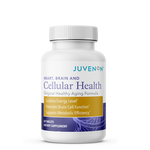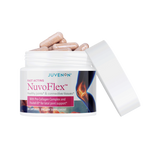
Metabolic imbalance can throw off how your body processes food and energy, causing lasting effects on your health.
In this article:
Balance in the Body
Metabolic Imbalance Definition
What Happens During Metabolism?
What Causes Metabolic Imbalance?
Metabolic Imbalance Symptoms
Phase II Enzyme System
What Disrupts Metabolic Balance?
Common Metabolic Imbalance Conditions
How to Achieve Metabolic Balance
Metabolic Balance and Metabolic Imbalance: How They Affect Health
Balance in the Body
We have all heard the words, “life is a balancing act.” The phrase usually applies to mixing work, play, and other activities to achieve a healthy mental-physical state.
It turns out that the health of our body at the biochemical level is also a balancing act that involves numerous metabolic pathways interacting and communicating with each other within the cells of our tissues and organs. As with the adage, “too much work makes Jack a dull boy,” it is also true that too much exposure to certain external factors, such as toxins, carcinogens (impacted by smoking, for example), or even food, can create a metabolic imbalance.
This metabolic imbalance, if not corrected, leads to some form of disease. So what is metabolic imbalance, and how does it occur?
Metabolic Imbalance Definition

A metabolic imbalance is simply a disruption in the balance of the body’s life-sustaining processes, e.g. glucose metabolism. It can trigger certain inflammatory processes and lead to a hyperactive immune system.
The responses triggered by metabolic imbalance are the body’s natural response to harmful pathogens. But a change in the metabolic balance of the body may be enough for the immune system to fight back against a threat that doesn’t exist.
What Happens During Metabolism?
When food is metabolized, some of it is converted into the sugar-fuel glucose. Glucose is transported into the bloodstream, and is detected by a sensor in the pancreas, which in turn secretes the hormone insulin.
Insulin is transported through the bloodstream to various tissues of the body including muscle, fat, and liver. The cells in these tissues also have sensors for insulin, which in turn latch onto the circulating insulin.
The interaction between insulin and its receptor activates a switch embedded in the cell’s membrane that turns on numerous signaling mechanisms in the cell. The cell then takes up the nutrient glucose, and either converts it to energy, or stores it in the form of fat.
What Causes Metabolic Imbalance?

The metabolic pathways contained within our cells evolved over a period of millions of years. They developed in response to the external environment, most importantly the availability of nutrients.
Because nutrients were sporadically available, our ancient ancestors often gorged themselves when a food source (a beached whale, a field of berries) was present. The pathway described above kicked in to deliver nutrients to the cells to be converted into energy.
Any excess was converted to stored fuel (fat) for sustenance until the next food source became available, often several days later.
An imbalance develops when the gorging goes on ad infinitum. Thanks to the agricultural revolution, people have become very efficient at producing foods, especially high energy foods (fat, sugar).
The typical adult now overeats continuously, resulting in obesity. Obesity was not a factor in the formation of our metabolic pathways, and it has a disrupting effect on metabolism.
Fat cells, although necessary for storing energy to get us through those nutrient-deficient times, become toxic when bloated with fat. The toxins impair the metabolic pathway that removes glucose from the blood.
This is known as insulin resistance, or the pre-diabetic state, and virtually always leads to full-blown diabetes. This is an example of metabolic imbalance that can be largely avoided by adopting healthier eating habits!
Metabolic Imbalance Symptoms
Metabolic imbalance, alternatively called metabolic syndrome, is an internal phenomenon. So, how do you know if you have it?
You can experience at least one of these metabolic syndrome symptoms:
- High insulin resistance
- Large waistline or increased waist circumference
- High blood pressure
- Fatigue
Talking about specific figures, these values indicate metabolic syndrome: HDL cholesterol below 40 mg/dL for men; less than 50 mg/dL for women Systolic blood pressure of 130 mm Hg or higher Diastolic blood pressure of 85 mm Hg or higher Fasting glucose levels greater than 100 mg/dL Waist circumference greater than 40 inches for men; 35 inches for women Triglyceride levels greater than 150 mg/dL
You may also be predisposed because of genetics, your previous and current health status, and your lifestyle. Risk factors for metabolic syndrome include: Obesity A sedentary or inactive lifestyle Those with hereditary history of diabetes Personal history of diabetes Women with polycystic ovarian syndrome Advanced age Sleep apnea Non-alcoholic fatty liver disease
Phase II Enzyme System

One metabolic balancing act is called the Phase II Enzyme System. This pathway evolved to protect us from toxins, both environmental (such as smoke) and those produced during normal metabolism (free radicals), by helping remove toxins from our tissues.
This also promotes the production of potent antioxidants, such as glutathione, to prevent cellular damage from free radicals and other oxidants. It appears to be more effective in protecting our tissues than individual antioxidants such as vitamins C and E.
What Disrupts Metabolic Balance?
1. Free Radicals
Evidence is accumulating to indicate that the metabolic activation of this system of enzymes is impaired in aged animals, making them much more susceptible to the damaging effects of toxins and oxidants. Recent research has demonstrated an intricate network of signaling pathways that are switched on in tissues confronted with environmental stress, such as a free radical.
These pathways (survival pathways) communicate with other pathways (death pathways) to determine whether the cell under stress is worthy of saving. In other words, is it best to rid the damaged cell from the tissue for the benefit of the remaining healthy cells, or is the damage limited, making it possible to repair and save the cell?
An imbalance in this metabolic system can cause pathology, cancer, or produce a lethargic organ (heart) due to a lack of sufficient cells.
2. Stress
Intense stress can disrupt metabolic balance. Older animals have a less responsive phase II enzyme system and consequently are more susceptible to the damaging effects of toxins.
However, a super dose of stress to the cells of our body, even a young body, can overwhelm even a robust phase II system, and throw it into a metabolic imbalance. One example is an overdose of the common analgesic acetaminophen (Tylenol®).
The effect is to suddenly deplete the liver of the phase II-produced antioxidant glutathione, which creates a metabolic imbalance that favors the death pathway.
If this is not corrected by treating the patient with a potent antioxidant, such as N-acetylcysteine (NAC), the patient will surely die, or at best require a liver transplant. The timely administration of the proper compound, such as NAC, therefore, can function as phase II metabolic balancer.
3. Age-Associated Metabolic

The aging process can also cause an imbalance in metabolism.
One credible theory is that errors accumulate in the cellular membranes where many of the metabolic signaling events occur. A cellular membrane clogged with oxidized proteins and lipids produces age-associated structures known as lipofuscin.
Lipofuscin, in turn, may interfere with the mobility of the machinery involved in the numerous membrane-associated signaling events required for regulation of the phase II enzyme system. Therefore, agents that protect membranes from toxic insults and accumulation of lipofuscin may help attenuate, or reduce the effects of age-associated metabolic imbalance in phase II regulation.
Protection of this structure, the membrane, may prove to be a primary factor in promoting health and longevity. Damage to other cellular components may be secondary to the interruption of membrane structure.
Common Metabolic Imbalance Conditions
With all that said, you might ask what exact conditions portray imbalance in our metabolism. Here are some examples:
Diabetes Mellitus
This is a metabolic disorder involving blood glucose and insulin, the glucose-digesting hormone produced by the pancreas. It occurs because:
- The body has become resistant (type 1 diabetes) to insulin. This usually results from bad food choices or genetics.
- The pancreas produces very little insulin to no insulin.
Polycystic Ovary Syndrome (PCOS)
PCOS is an imbalance in the reproductive hormones which affects the number of eggs the ovaries produce each cycle. It may lead to:
- Infertility
- Irregular or missed menstrual periods
- Cysts in the ovary
How to Achieve Metabolic Balance
Metabolic imbalance can have the potential to escalate into more serious, long-term conditions. But reducing risk factors plays a great role in minimizing its effects on your body and improves your health overall.
1. Lifestyle Changes
Lifestyle changes focusing on heart-health are crucial in preventing metabolic imbalance and restoring metabolic balance. More physical exercise and eating healthy foods can help in the reduction of the excess weight around the abdomen, and improve the metabolism as well.
2. Regular Checkup
Regular visits to your primary health care provider can help in keeping track of levels of cholesterol, blood sugar, and blood pressure.
3. Compliance to Prescribed Meds
Doctors may also prescribe medications for high blood pressure, low HDL, high blood sugar, and high triglyceride levels. Take them as prescribed so as to not interfere with the natural metabolic processes of your body.
Metabolic imbalance is not ideal for anyone, but can easily be prevented and properly managed with the right treatment and lifestyle changes. Taking a healthy supplement may also be helpful in keeping your metabolism on track.
QUESTION:
Can you tell me under what conditions lipoic acid can act as a pro-oxidant? Is it due to its involvement in glucose metabolism?— G.K G.K., via email
Benjamin V. Treadwell, Ph.D. is a member of Juvenon’s Scientific Advisory Board and formerly an associate professor at Harvard Medical School.
ANSWER:
It is not certain whether lipoic acid can become a pro-oxidant under physiological conditions. But remember, an antioxidant, once it has done its job of neutralizing an oxidant, itself becomes oxidized and therefore is essentially a pro-oxidant. However, under normal conditions antioxidants such as lipoic acid and vitamins C and E have enzymatic pathways that quickly convert them back into antioxidant condition.
In light of the obesity epidemic, scientists have redoubled their efforts to understand the signaling mechanisms in the brain that regulate appetite and monitor levels of stored food and circulating nutrients. The signaling protein mTOR, acting on the hypothalamus within a signaling complex, has been shown to modulate feeding and body weight. For further information on this research, click here. “mTOR tells the brain that the body is hungry” Nature Medicine 12, 615 – 617 (2006).
This Research Update column highlights articles related to recent scientific inquiry into the process of human aging. It is not intended to promote any specific ingredient, regimen, or use and should not be construed as evidence of the safety, effectiveness, or intended uses of the Juvenon product. The Juvenon label should be consulted for intended uses and appropriate directions for use of the product.
Editor’s Note: This post was originally published on October 3, 2019, and has been updated for quality and relevancy.



















